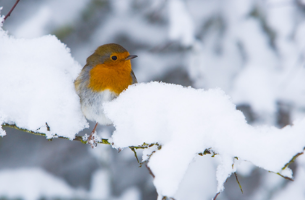If you're hand-holding, you'll need a fairly high shutter speed – around 1/500sec or faster – to avoid blur; slower if you're steadying the camera on a tripod or similar. A lens with built-in vibration reduction (VR) will allow you to handhold at up to four stops slower, enabling a handheld shutter speed of 1/60sec or 1/125sec, which makes all the difference on a dark winter's day. Boost your ISO for a faster shutter speed, but it's good practice to use the lowest you can get away with to get the cleanest image, which can be crucial with a highly magnified close-up.
To capture robins feeding or perching, choose aperture priority mode and use a wide-open aperture like f/2.8 or f/4 for a shallow depth of field which throws the background beyond focus, concentrating attention on the bird and its immediate surroundings. Prefocus on the perch you know the robin favours, so you're ready to shoot when the bird lands on it.

